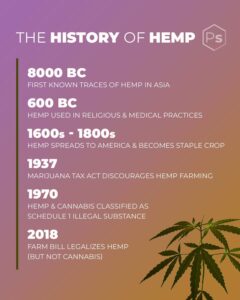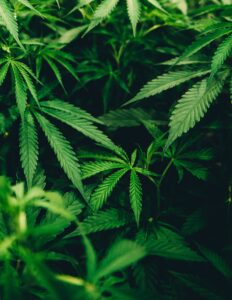Hemp – the non-psychoactive cousin of the cannabis plant – is known for its role in sourcing modern-day cannabinoid (CBD) products. But the hemp we know today isn’t new to the farming industry. In fact, ancient societies have cultivated hemp for thousands of years – all across the globe. Hemp and its close relative, cannabis, were actually ancient agricultural giants. Since the cradle of human civilization in Mesopotamia, nations have harvested these plants as a means of survival and technological advancement.

Hemp in Ancient Agriculture
Many historians posit that the beginning of hemp agriculture likely began 10,000 years ago! Scientists and archeologists agree that the plant originated in Asia around 8000 BC. Researchers have found traces of hemp and cannabis primarily in Taiwan, China, and early Hindu nations – while later traces were found in South America, Africa, Greece, and Russia. Nations first harvested the hemp plant to make a variety of everyday items – including clothes, rope, and paper. In Africa and South America, hemp seed and hemp oil were also used in food production and to create pottery.
Early Spiritual Practices
Soon after ancient nations discovered the versatility of strong hemp fibers, they began to learn about the cannabis plant’s psychoactive properties. Many historians believe that while nations harvested hemp for everyday uses, they simultaneously harvested cannabis for spiritual or religious practices.
The earliest findings show that around 500-600 BC ancient civilizations began to harness the psychoactive effects induced by the higher levels of THC in cannabis. This “high” feeling first became associated with spiritual awakening, communication, and healing in ancient China. In fact, a team of archeologists working on a remote mountain plateau in Central Asia recently discovered evidence of mourners inhaling cannabis smoke during funeral ceremonies over 2,500 years ago!

Early Medical Practices
Early Greek and Roman societies used both cannabis and hemp in pharmacology. Pliny and Galen – two notable Roman naturalists – wrote extensively about the medical use of cannabis and hemp. In addition to the ancient recreational use of cannabis, medicinal hemp was used to alleviate common ailments – including inflammation, skin lesions, digestive issues, gout, and some muscular disorders.
But the medical use of hemp did not end with the Roman Empire. An Irish doctor in the early 1800s discovered the gastrointestinal benefits of using the plant. He found that hemp could effectively prevent nausea and vomiting in cholera patients. Soon after his discovery, hemp extract became widely available in pharmacies and doctor’s offices throughout the late 1800s as a medical treatment for everyday aches and pains.
Hemp in the Western Hemisphere
After taking root in China, the hemp plant was brought along major trading routes like the Silk Road. These routes spread the cultivation of hemp and cannabis to the outermost corners of Europe. King Henry VII of England actually legitimized hemp’s agricultural benefits by requiring his farmers to harvest the plant. Once established as a staple in the most influential nations of Europe, it wasn’t long before the American colonies discovered the economic benefits of farming the plant. And American colonial governments even required farmers to cultivate it by law. Thus, hemp and cannabis quickly spread to the Western Hemisphere.
Early American citizens used the hemp plant throughout the 19th century much in the same way that ancient civilizations did – for clothes, shoes, paper, rope, and even food. And in 1916, the USDA published findings that hemp produced paper more efficiently than using trees alone, producing approximately four times the amount of paper per acre. Hemp was widely popular in the early United States – right up next to tobacco, corn, and other agricultural staples!

Mixed Sentiments
Unfortunately, hemp didn’t retain its reputation as a super-crop. Around the early 1900s, American attitudes towards hemp began to change in response to its plant-relative, cannabis (which soon became known by its Spanish translation “marijuana”). In 1937, the Marijuana Tax Act signaled the beginning of the hemp industry decline. Although this legislation specifically targeted the production and distribution of cannabis, lawmakers lumped the non-recreational relative hemp into the ‘marijuana’ category. Farmers found this staple crop now heavily taxed and extremely discouraged.
A homefront campaign during World War Two titled “Hemp for Victory” proved a brief increase in hemp production, as the plant was used to make necessary provisions for troops overseas. However, the Controlled Substances Act of 1970 classified hemp – alongside cannabis – as an illegal Schedule 1 substance. It wasn’t until 2018 when the Farm Bill finally declassified hemp as an illegal drug, permanently separating legal hemp and illegal cannabis in the eyes of lawmakers.
What Now?
Since hemp’s declassification as an illegal substance in 2018, a renewed interest in the plant has skyrocketed the hemp farming industry. Administrators dedicated 500,000 acres of farmland to the production of hemp in 2019, and the CBD industry began to grow steadily among consumer markets.
When we think about the cannabis plant, we often overshadow the rich history of hemp – from ancient civilizations to modern-day CBD products. But hemp and cannabis alike were central to the development of early human civilizations. Versatile in nature, nations across the globe have benefitted from the hemp plant in spiritual practices, medical discoveries, and technological advancement. The healing benefits of the hemp plant were no secret in ancient times: why overlook them now?
If you want to learn more about hemp and CBD, check out the new categories section on the Physician Selected blog!
